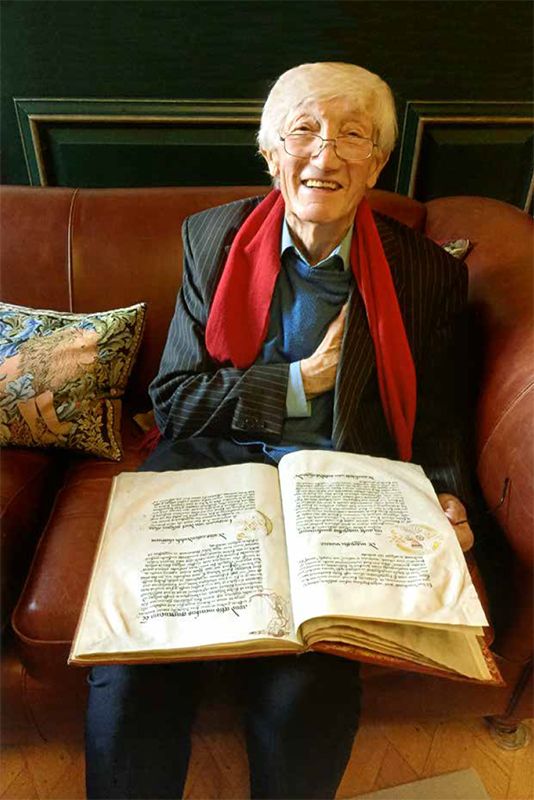In memoriam Geoffrey T. Martin
Op 7 maart jl. ontving het Rijksmuseum van Oudheden het droevige nieuws van het overlijden van de Britse egyptoloog Geoffrey Martin (geboren 1934). Na zijn studie in Londen en Cambridge (1964-1970) was Martin als docent verbonden aan University College Londen. Van 1988 tot zijn emeritaat in 1993 was hij daar Professor in de Egyptische archeologie en filologie. Naast zijn onderwijsbaan verrichtte hij bijna jaarlijks opgravingen in Amarna, Thebe en Sakkara. In die laatste vindplaats werkte Martin, als veldleider van de Britse Egypt Exploration Society, nauw samen met het Rijksmuseum van Oudheden, een ‘joint venture’ dat leidde tot vele spectaculaire ontdekkingen.
Amarna
Martins speciale interesse gold de kunst en archeologie van de zogenaamde Amarna-periode, waarin de Egyptische farao Achnaton een culturele en religieuze revolutie ontketende. Dat verklaart zijn opgravingen in de koningsgraven van Amarna en het Thebaanse Dal der Koningen, maar ook Sakkara past helemaal in dit thema. Tussen 1820 en 1830 waren hier immers talloze kunstvoorwerpen gevonden uit de Amarna-periode en vlak daarna (ca. 1350-1250 v.Chr.). De opbrengst werd verkocht aan vele musea ter wereld, en ook het Rijksmuseum van Oudheden bezit een groot aantal van deze schatten. Maar er bestaat geen nauwkeurig verslag van deze vroege exploitatie en zelfs de ligging van het grafveld was 150 jaar later vrijwel onbekend. Martin had een idee waar het gezocht moest worden, Leiden wilde graag meehelpen dit mogelijk te maken, en in januari 1975 begon de gemeenschappelijke expeditie opgravingen in de toen nog maagdelijke woestijn in Zuid-Sakkara.
Horemheb
Ik had het geluk om als student egyptologie mee te mogen met dit nieuwe opgravingsproject. Binnen een week vonden we het eerste en belangrijkste grafmonument uit de gezochte periode: de graftempel van Toetanchamons generaal Horemheb. Volgende seizoenen brachten het ene na het andere graf aan het licht. Het is geen overdrijving te zeggen dat deze vondsten ook mijn eigen carrière bepaalden, want ik bleef na mijn studietijd verbonden aan het Rijksmuseum van Oudheden en aan de opgravingen in Sakkara. Tussen 1975 en 1998 (toen de Egypt Exploration Society zich terugtrok uit het project, en ikzelf veldleider werd) zat ik daardoor bijna jaarlijks enkele maanden in het opgravingshuis aan Martins zijde. Met zijn aanstekelijke enthousiasme en fabelachtige expertise leerde hij mij alle aspecten van het vak: het opgraven, de vondstanalyse, het tekenen van wandreliëfs en inscripties. Bovenal inspireerde zijn enorme discipline, want zelfs de meest vermoeiende veldwerkdag eindigde ’s avonds met zijn vaste opmerking: “And now I must write a book!”, waarna hij zich terugtrok achter zijn bureau. Ik zal Geoffrey Martin eeuwig erkentelijk zijn…
On March 7th, the Leiden Museum of Antiquities received the sad news regarding the death of British Egyptologist Geoffrey T. Martin (born 1934). After his studies in London and Cambridge (1964–1970), Martin became attached to University College London as lecturer, reader, and from 1988 until his retirement in 1993 as Professor of Egyptian Archaeology and Philology. Apart from his teaching, Martin executed almost yearly excavations at Amarna, Thebes, and Saqqara. Fieldwork at the latter site was performed in close collaboration of the Egypt Exploration Society (with Martin as field director) and the Leiden Museum, a joint venture which resulted in numerous spectacular discoveries.
Amarna
It was the art and archaeology of the Amarna period, when the Egyptian pharaoh Akhenaten started a cultural and religious revolution, which enjoyed Martin’s special interest. This explains his excavations in the royal tombs at Amarna and Thebes, but also those at Saqqara. Numerous art treasures dating to the Amarna period and immediately after (c. 1350–1250 BC) were found there between 1820 and 1830. The treasure hunters sold their finds to museums all over the world, and the Leiden Museum also shared in these objects. However, no exact record exists of this early exploitation, whereas after 150 years even the position of the cemetery was utterly unknown. Martin had some idea where it was to be found, Leiden was eager to contribute to the effort, and in January 1975 the common expedition started digging in what then still was the virgin desert of South-Saqqara.
Horemheb
As a student of Egyptology, I had the unique opportunity to join the new excavation project. Within a week we found the first and most important funerary monument of the relevant period: the temple-tomb of Tutankhamun’s general Horemheb. The following seasons brought to light one tomb after the other. It is no exaggeration to state that these finds also determined my personal career, because after my studies I stayed connected with the Leiden Museum and the Saqqara excavations. Almost annually from 1975 until 1998 (when the Egypt Exploration Society stopped the cooperation, and I myself became field director), I spent a couple of months in the Saqqara dighouse in Martin’s company. With his contagious enthousiasm and fabelous expertise, he taught me all aspects of the work: the actual dig, the analysis of the finds, the epigraphic recording of the wall reliefs and inscriptions. Most inspiring was his enormous discipline, for at the end of even the most tiring day in the field he used to say: ‘And now I must write a book!’ – after which he retired behind his desk. I shall always be grateful to Geoffrey Martin…

Foto/photo: prof. Jane Stapleton
Reacties